Learn how to trap-bar deadlift with proper form and get a free trap-bar deadlift workout!
The post How to Trap-Bar Deadlift with Proper Form (with a Free 12-Week Training Plan!) appeared first on Legion Athletics.
[h=4]Key Takeaways[/h]
The trap-bar deadlift was birthed in the mid-1980s by a powerlifter named Al Gerard.
Gerard discovered his talent at a young age hoisting sacks of fertilizer in a factory where he worked, and then his passion pulling and pushing barbells in his thirties. By his forties, he was pulling over 600 pounds, but he had also developed a nagging lower-back injury that made any further progress unlikely.
He tried to “train around” his injury by doing dumbbell squats and lunges, rack pulls, and other exercises, but wanted a back-friendly option that more closely mimicked the deadlift.
And after some fiddling, Gerard came up with what he called the “Gerard Device.” Here’s what it looked like:
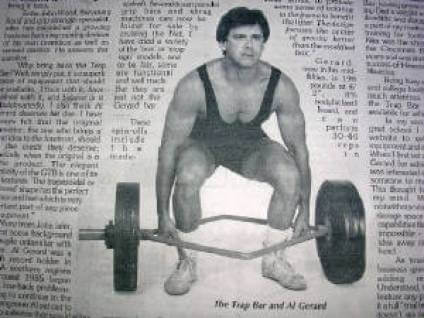
It worked as intended—it allowed him to train his hamstrings, glutes, and back muscles without the lower-back strain of traditional deadlifts. Gerard’s innovation quickly caught on in the weightlifting community as a viable exercise, and although nobody knows why, in time, it became known as the “trap-bar deadlift.”
Maybe people thought it was primarily for training the trapezius (“trap”) muscles, or maybe it was because it resembles a bear trap, or maybe because it looks like the lifter is “trapped” inside the bar when using it.
In any case, the trap-bar deadlift reached new levels of popularity in the mid-2000s, when NFL players and other athletes began using it. And now, you’ll find a trap bar in just about every gym you go to.
You’ll also find the trap-bar deadlift in many popular weightlifting programs for everyone from competitive athletes to geriatrics, and for a good reason: it works.
In addition to being easier on your lower-back than the traditional deadlift, the trap-bar deadlift also offers several advantages that make it worth including in your routine even if you aren’t hurt or hurting.
And in this article, you’ll learn why, along with how to trap-bar deadlift with proper form, how to incorporate it into your workout routine, and more.
[h=2]What Is the Trap-Bar Deadlift? [/h]The trap-bar deadlift, also known as the hex-bar deadlift, is the same as the conventional deadlift except it’s performed with a trap bar.
Here’s what it looks like:
It also changes how the exercise feels. When using a trap bar, it feels like you’re pulling the bar straight up, whereas when using a barbell, it feels like you’re using your body as a lever to pry the bar off the ground.
Trap bars also differ from barbells in that they have two pairs of handles:
In fact, it trains almost every major muscle group in your body, excluding your legs, arms, and glutes.
Specifically, it helps develop your . . .
Thus, the trap-bar deadlift is really a full-body exercise that trains more or less every muscle in your posterior chain (the muscles on the backside of the body).
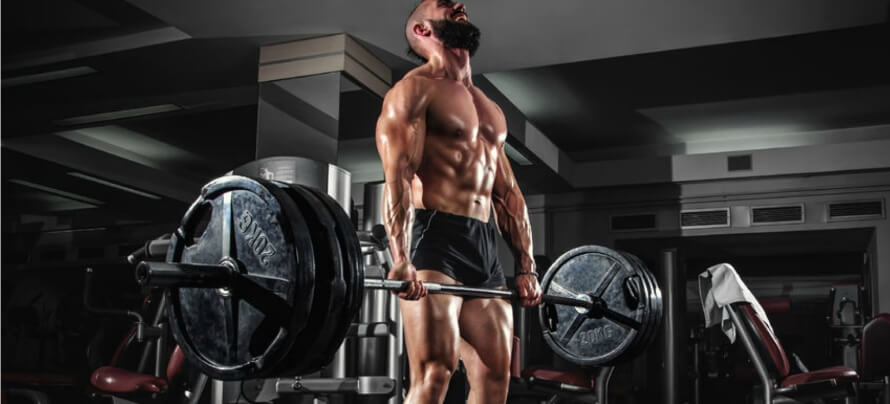
The trap-bar deadlift is one of the few back exercises that rivals the conventional barbell deadlift. Although they look different at first glance, they’re far more similar than most people realize.
Both exercises do a phenomenal job of training your lower-back, glutes, and hamstrings, although the barbell deadlift puts more stress on the lower-back and hamstrings, and the trap-bar deadlift puts more stress on the quads. You can think of the trap-bar deadlift as a “squattier” version of the barbell deadlift.
Just as Al Gerard intended, most people find it more comfortable, too, because it puts your back in a more upright position and your knees and ankles flex a little more, but otherwise, it’s biomechanically identical to the conventional deadlift.
Most people also prefer the neutral grip of the trap-bar deadlift more than the grip you have to use to barbell deadlift, and can better keep the weight balanced over the midfoot while maintaining stability and strength throughout the entire movement.
Because you don’t have to use a mixed grip, as you often do with a barbell deadlift, this helps reduce the risk of muscle imbalances and biceps tears. Thanks to the biomechanics of the exercise, there’s also no risk of hyperextending your back with the trap-bar deadlift like there is with the barbell deadlift. And finally, since the trap-bar never makes contact with your legs, there’s no risk of rubbing your shins raw like there is with the barbell deadlift.
Additionally, most people can lift around 5 to 10% more on the trap-bar deadlift (even when using the low handles) than they can with the barbell deadlift, which allows you to use maximally heavy weights. This makes it particularly appealing to new weightlifters, who have yet to build up their barbell deadlift.
Because the trap-bar deadlift is “easier,” though, some people dismiss it as merely a “deadlift-with-training-wheels”—an exercise to help newbies learn how to pull properly.
This is wrongheaded.
While it’s true the trap-bar deadlift is “easier” in that it allows you to lift more weight, you can make it just as hard as the conventional deadlift by . . . wait for it . . . lifting more weight.
For example, if you can conventionally deadlift, let’s say, 300 pounds, and you then trap-bar deadlift 330 pounds, both will help you gain muscle and strength almost equally.
Another benefit of the trap-bar deadlift is that it’s probably more effective at improving athletic performance than the barbell deadlift.
Most sports demand not only strength, but also speed. Combined, these factors are referred to as power, and exercises that allow you to produce more power (to produce strength faster) are generally considered more beneficial for improving athleticism.
Several studies have found that weightlifters are able to pull trap bars faster than barbells and generate more power as a result, which means the trap-bar deadlift may be slightly better than the barbell deadlift for athletes.
For example, a study conducted by scientists at the University of Chichester had 11 male weightlifters aged 20-years old do three sets of one rep of the trap-bar deadlift and barbell deadlift. In both cases, they used 90% of their one-rep (1RM) max for each exercise. That is, if their barbell deadlift 1RM was 300 pounds, they’d use 270 for that exercise; and if their trap-bar deadlift 1RM was 330, they’d use 300 for that exercise.
The researchers used a bar speed tracker to calculate the weightlifter’s bar speed, power output, time spent lifting the bar and total energy production during each set for all three sets of each exercise.
After crunching the numbers, they found that the trap-bar deadlift beat the barbell deadlift on almost every measure. The weightlifters were able to complete their reps faster with the trap bar and produced more force, power, and energy.
This isn’t proof positive that the trap-bar deadlift will improve your athletic performance more than the barbell deadlift, but it’s worth considering when building a workout routine.
None of this is to say the trap-bar deadlift is flat-out superior to the barbell deadlift, but research shows it’s certainly not inferior, either.
So, to sum up, the main reasons you want to consider trap-bar deadlifting are:
Personally, I like to switch from the barbell to the trap-bar deadlift every 12 to 16 weeks to give my hips, back, knees, and shoulders (if you use a mixed grip) a break and to keep my training interesting.
I’ve also found that both exercises tend to be complimentary—a period of trap-bar deadlifting seems to improve my barbell deadlift, and vice versa.
Let’s go through each one in detail, starting with the setup.
[h=3]Trap-Bar Deadlift Form Step 1: The Setup[/h]Load up the trap bar and position your feet about shoulder-width apart inside the rectangular center of the bar, like this:
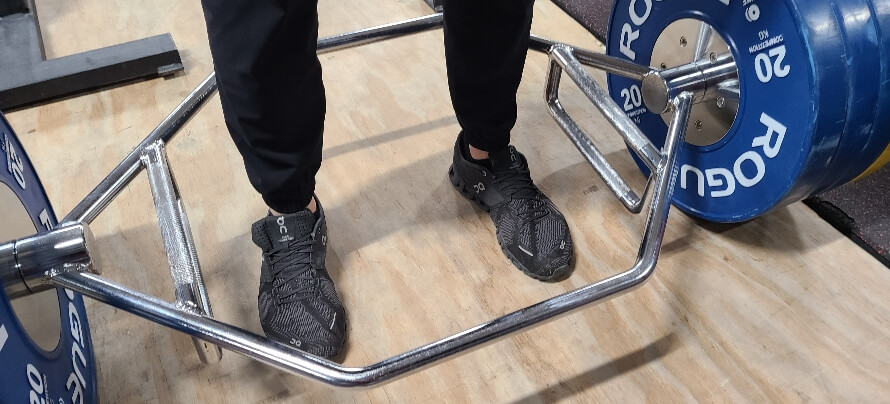
Squat down and grab the middle of the handles (either the high or low ones), and give the bar a little tug—just enough so that you can tell whether your feet are too far forward or backward. If the bar starts to roll backward, move your feet a smidge forward, and if the bar starts to roll forward, move your feet a little backward.
You want to adjust your foot position so that when you tug on the bar, it doesn’t move forward or backward, but straight up (this means it’s properly positioned over your center of gravity). In most cases, this will put the ends of the trap bar (where the plates are loaded) in line with your midfoot and your shoulders roughly above your toes.

In the first image, the bar is too far forward; in the second image, the bar is too far backward; and in the last image, the bar is in the proper position over my midfoot.
You also want to adjust your grip so that the bar stays mostly level as you pull—it shouldn’t tilt forward or backward.
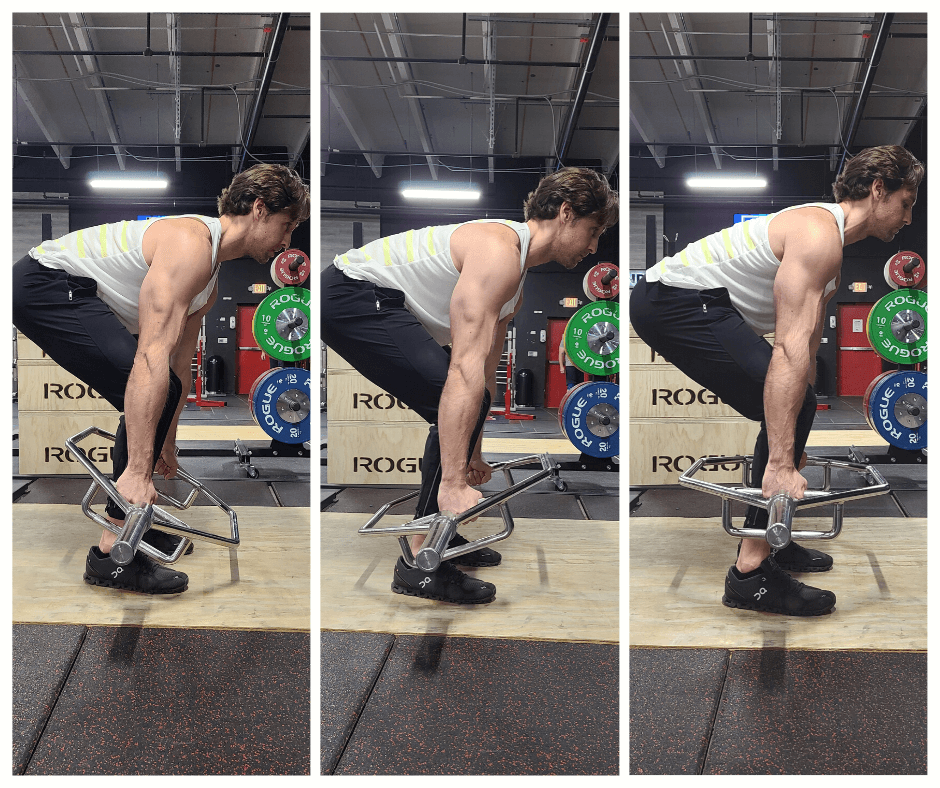
In the first image, the bar is tilted forward; in the second image, the bar is tilted backward; and in the last image, the bar is level, as it should be.
This may feel slightly awkward at first, but you’ll get a feel for where you should position your feet and grip the handles within your first few workouts.
Next, you want to . . .

You should feel some tightness in your hamstrings and hips as you get into this “half squat” position. This is desirable because as soon as your hips rise, your shoulders will be able to follow, and the weight will immediately start coming off the floor.
Don’t make the newbie mistake of bringing your hips too low with the intention of “squatting” the weight up. The lower your hips are in the starting position, the more they’ll have to rise before you can lift the weight off the floor, and this wastes energy.
You’re now ready to ascend.
[h=3]Trap-Bar Deadlift Form Step 2: The Ascent[/h]Start the pull by forcefully driving your body upward and pushing your feet into the floor. As you begin to pull, remember to keep your lower-back slightly arched (no rounding!), like this:
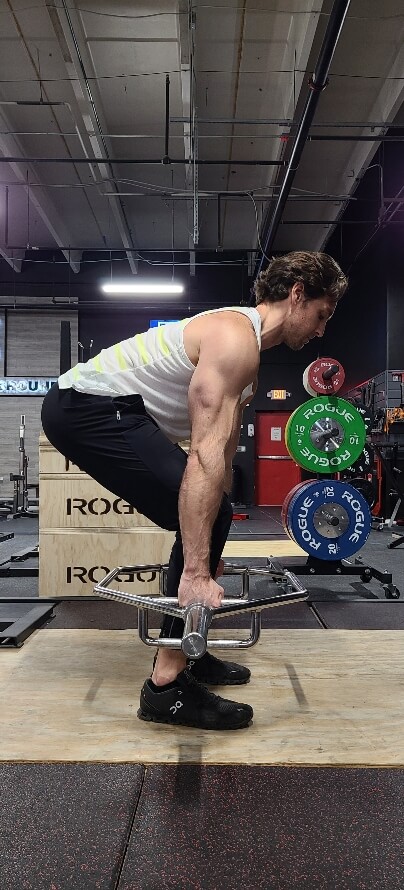
Ensure that your hips and shoulders rise simultaneously. Don’t shoot your hips up and then use your back like a lever to raise your shoulders. If your hips are moving up, your shoulders should be as well.
The bar should move up in a straight line. If you find the bar moving away from you (pulling you forward), that’s a sign you either need to work on your setup or that you aren’t keeping your upper body tight throughout the rep.
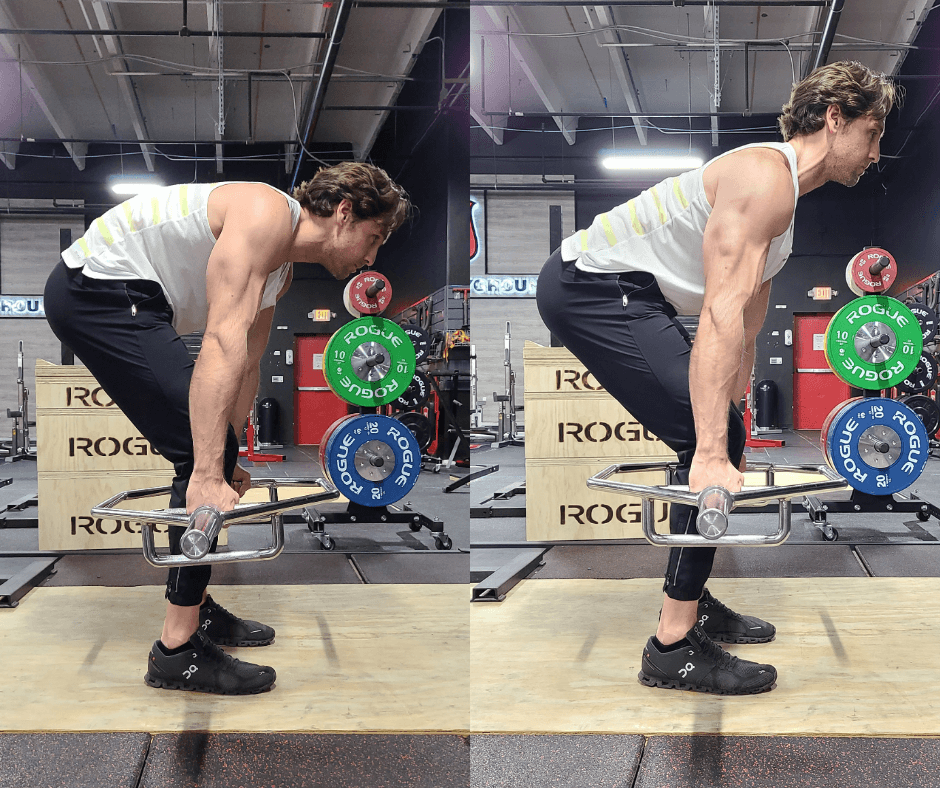
In the first image, my spine is rounded (bad), but in the second image, my spine is in the proper, neutral position (good).zThe entire way up, keep your head in its neutral position in line with your spine, your lower-back slightly arched, and your core tight.
As the bar passes your knees, push your hips forward so that you’re standing up straight with your chest up and your shoulders down. Don’t lean back or shrug the weight up.
Here’s how you should look at the top of the ascent:
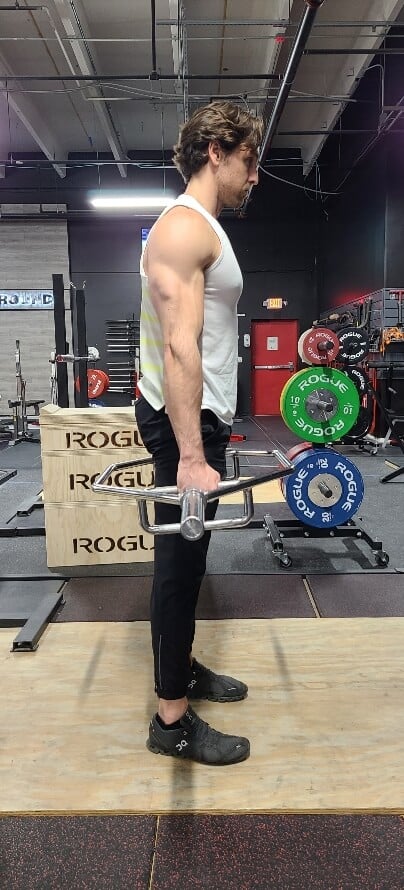
You’re now ready to descend.
[h=3]Trap-Bar Deadlift Form Step 3: The Descent[/h]The next half of the trap-bar deadlift is lowering the weight back down to the floor in a controlled manner. This is basically a mirror image of what you did to stand up.
Begin by pushing your hips back, not bending at the knees, allowing the bar to move straight down toward the ground. Continue pushing your hips back, lowering the bar until the plates are resting on the floor.
Your lower-back should remain locked in its neutral position the entire time, and your core should remain tight. Don’t try to lower the bar slowly or quietly. The entire descent should take one to two seconds or less.
You’re now ready for the next rep.
Many people don’t stop to reset in between reps and instead use the tap-and-go transition, which has you maintain tension as you tap the weights to the floor and immediately begin the next rep.
This is fine if you’re warming up, but I prefer the stop-and-go method for my hard sets. This method has you relax your body after lowering the weight on the floor and reset your bottom position before starting the next rep. This is harder than tap-and-go, but that’s good, and it’s safer as well.
[h=2]A Simple, Effective, and Challenging Trap-Bar Deadlift Workout[/h]As you now know, the trap-bar deadlift isn’t all that different from the barbell deadlift. In fact, it’s easier for most people to learn, but that doesn’t mean it’s less effective for gaining muscle and strength.
When it comes to workout programming, you can treat the trap-bar deadlift more or less the same as the barbell deadlift.
Since it’s a full-body, compound exercise, you usually want to do it at the beginning of your workouts when you’re feeling freshest, and it typically works best when performed for relatively low reps (eight or fewer).
With that in mind, here’s a simple and effective trap-bar deadlift workout that includes several other exercises for your back and hamstrings.

[h=3]Warm up before each workout.[/h]When you warm up for the trap-bar deadlift (or any other exercise), here’s the protocol you want to follow:
After your warm-up and hard sets for the trap-bar deadlift, you don’t need to warm up for the rest of the exercises in the workouts—your muscles will be plenty warm already.
If you want to learn more about the importance of a proper warm-up and how to warm up for different workouts, check out this article:
[h=3]Use Reps In Reserve (RIR) to control workout intensity.[/h]Reps in Reserve (RIR) is a method of controlling your workout intensity, and it works like this:
1 RIR = 1 rep shy of failure
2 RIR = 2 reps shy of failure
3 RIR = 3 reps shy of failure
. . . and so on.
For all of the exercises in this workout, I recommend you use an intensity of 1 to 2 RIR, which means you want to do as many reps as you can within the prescribed rep range until you feel you can only do 1 or 2 reps more and then stop.
For example, if you’re doing 3 sets of 4 to 6 reps of trap-bar deadlifts, you want to pick a weight that allows you to finish each of your sets feeling like you could have pulled 1 or 2 more reps if you absolutely had to, while completing at least 4 reps and not more than 6.
Check out this article if you want to learn more about how to use Reps in Reserve to improve the effectiveness of your workouts:
[h=3]Once you hit the top of your rep range for one set, add weight.[/h]For instance, if you trap-bar deadlift 225 pounds for 6 reps on your first set, you then add 5 pounds to each side of the bar for your next set.
If, on the next set, you can get at least 4 reps with 235 pounds, that’s the new weight you work with until you can pull it for 6 reps, move up, and so forth.
If you get 3 or fewer reps, though, reduce the weight added by 5 pounds (230 pounds) and see how the next set goes. If you still get 3 reps or fewer, reduce the weight to the original 6-rep load (225 pounds) and work with that until you can do two 6-rep sets with it, and then increase the weight on the bar.
This method is known as double progression, which you can learn about in this podcast:
[h=3]Don’t go to absolute muscle failure every set.[/h]Muscle failure is the point where you can no longer keep the weight moving or maintain proper form and have to end the set.
We should take most of our sets close (but not all the way) to muscle failure.
Research shows taking sets to failure isn’t any more beneficial for muscle growth than taking sets one to two reps shy of failure, and it can increase the risk of injury or burnout. This is particularly true on compound exercises like the squat, deadlift (trap-bar or barbell), bench press, and overhead press.
Thus, this is why I recommend you take all of your sets one to two reps shy of failure (1 to 2 RIR), but not all the way to failure (0 RIR).
You can learn more about how to take sets close (but not to) failure in this article:
[h=3]Rest 3 to 4 minutes in between each set.[/h]This gives your muscles enough time to fully recoup their strength so you can give maximum effort each set.
If you want to learn more about how long you should rest between sets, check out this article:
[h=2]The Bottom Line on the Trap-Bar Deadlift[/h]Although many people dismiss the trap-bar deadlift as an inferior bastardization of the barbell deadlift, it’s not.
The trap-bar deadlift is just as effective for gaining strength and muscle as the traditional exercise because like the barbell deadlift, it trains almost every major muscle group in your body, including your back, glutes, hamstrings, quadriceps, calves, and forearms.
It’s also more comfortable and easier to learn for most people.
Although the trap-bar deadlift is a very safe exercise, it’s still essential to use proper form to avoid injury and maximize results. Here’s how:
If you liked this article, please share it on Facebook, Twitter, or wherever you like to hang out online!

[h=3]What’s your take on the trap-bar deadlift? Have anything else to share? Let me know in the comments below![/h]The post How to Trap-Bar Deadlift with Proper Form (with a Free 12-Week Training Plan!) appeared first on Legion Athletics.
{feed:enclosure_href }
More...
The post How to Trap-Bar Deadlift with Proper Form (with a Free 12-Week Training Plan!) appeared first on Legion Athletics.
[h=4]Key Takeaways[/h]
- The trap-bar deadlift is one of the most underrated exercises you can do. It’s about as good as the barbell deadlift for gaining muscle and strength, and most people find it more comfortable, easier to learn, and forgiving on their lower back.
- Learning proper trap-bar deadlift technique boils down to developing a few simple habits and remembering a handful of effective cues.
- Keep reading to learn why the trap-bar deadlift is so effective, how it compares with the barbell deadlift, and how to incorporate the trap-bar deadlift into your workouts.
The trap-bar deadlift was birthed in the mid-1980s by a powerlifter named Al Gerard.
Gerard discovered his talent at a young age hoisting sacks of fertilizer in a factory where he worked, and then his passion pulling and pushing barbells in his thirties. By his forties, he was pulling over 600 pounds, but he had also developed a nagging lower-back injury that made any further progress unlikely.
He tried to “train around” his injury by doing dumbbell squats and lunges, rack pulls, and other exercises, but wanted a back-friendly option that more closely mimicked the deadlift.
And after some fiddling, Gerard came up with what he called the “Gerard Device.” Here’s what it looked like:

It worked as intended—it allowed him to train his hamstrings, glutes, and back muscles without the lower-back strain of traditional deadlifts. Gerard’s innovation quickly caught on in the weightlifting community as a viable exercise, and although nobody knows why, in time, it became known as the “trap-bar deadlift.”
Maybe people thought it was primarily for training the trapezius (“trap”) muscles, or maybe it was because it resembles a bear trap, or maybe because it looks like the lifter is “trapped” inside the bar when using it.
In any case, the trap-bar deadlift reached new levels of popularity in the mid-2000s, when NFL players and other athletes began using it. And now, you’ll find a trap bar in just about every gym you go to.
You’ll also find the trap-bar deadlift in many popular weightlifting programs for everyone from competitive athletes to geriatrics, and for a good reason: it works.
In addition to being easier on your lower-back than the traditional deadlift, the trap-bar deadlift also offers several advantages that make it worth including in your routine even if you aren’t hurt or hurting.
And in this article, you’ll learn why, along with how to trap-bar deadlift with proper form, how to incorporate it into your workout routine, and more.
- [h=4]Table of Contents[/h]
- What Is the Trap-Bar Deadlift?
- What Muscles Does the Trap-Bar Deadlift Train?
- Why Trap-Bar Deadlift?
- Proper Trap-Bar Deadlift Form 101
- Trap-Bar Deadlift Form Step 1: The Setup
- Trap-Bar Deadlift Form Step 2: The Ascent
- Trap-Bar Deadlift Form Step 3: The Descent
- A Simple, Effective, and Challenging Trap-Bar Deadlift Workout
- Warm up before each workout.
- Use Reps In Reserve (RIR) to control workout intensity.
- Once you hit the top of your rep range for one set, add weight.
- Don’t go to absolute muscle failure every set.
- Rest 3 to 4 minutes in between each set.
- The Bottom Line on the Trap-Bar Deadlift
[h=2]What Is the Trap-Bar Deadlift? [/h]The trap-bar deadlift, also known as the hex-bar deadlift, is the same as the conventional deadlift except it’s performed with a trap bar.
Here’s what it looks like:
The most obvious difference between deadlifting with a trap bar versus a conventional barbell is that you step inside a trap bar to lift it, whereas you hold a barbell in front of your body. Because of this, the trap bar is easier to balance over your center of gravity, which makes the trap-bar deadlift more comfortable and easier to learn than the conventional deadlift for most people. It also changes how the exercise feels. When using a trap bar, it feels like you’re pulling the bar straight up, whereas when using a barbell, it feels like you’re using your body as a lever to pry the bar off the ground.
Trap bars also differ from barbells in that they have two pairs of handles:
- “Low handles” which are positioned at the same height as a regular barbell would be when loaded with standard 45-pound plates (8.75 inches).
- “High handles” which are positioned three to four inches higher than the low handles, reducing the range of motion and making the exercise slightly easier (and less effective).
Summary: The trap-bar deadlift is an effective, easier, and more comfortable variation of the barbell deadlift.
[h=2]Get Your Free Trap-Bar Deadlift Training Program Now[/h] Enter your email address below to get 12 weeks’ worth of 3, 4, and 5-day per week trap-bar deadlift workouts, all expertly laid out in Google Sheets.
Sending...
Your free stuff is on the way!
Looks like you're already subscribed!
[h=2]What Muscles Does the Trap-Bar Deadlift Train?[/h]Most people consider the trap-bar deadlift a “back exercise,” but it trains far more than just your back. Sending...
Your free stuff is on the way!
Looks like you're already subscribed!
In fact, it trains almost every major muscle group in your body, excluding your legs, arms, and glutes.
Specifically, it helps develop your . . .
Thus, the trap-bar deadlift is really a full-body exercise that trains more or less every muscle in your posterior chain (the muscles on the backside of the body).
Summary: The trap-bar deadlift effectively trains almost every major muscle group in your body, and it’s particularly effective for training your back, hamstrings, and glutes.
[h=2]Why Trap-Bar Deadlift?[/h]

The trap-bar deadlift is one of the few back exercises that rivals the conventional barbell deadlift. Although they look different at first glance, they’re far more similar than most people realize.
Both exercises do a phenomenal job of training your lower-back, glutes, and hamstrings, although the barbell deadlift puts more stress on the lower-back and hamstrings, and the trap-bar deadlift puts more stress on the quads. You can think of the trap-bar deadlift as a “squattier” version of the barbell deadlift.
Just as Al Gerard intended, most people find it more comfortable, too, because it puts your back in a more upright position and your knees and ankles flex a little more, but otherwise, it’s biomechanically identical to the conventional deadlift.
Most people also prefer the neutral grip of the trap-bar deadlift more than the grip you have to use to barbell deadlift, and can better keep the weight balanced over the midfoot while maintaining stability and strength throughout the entire movement.
Because you don’t have to use a mixed grip, as you often do with a barbell deadlift, this helps reduce the risk of muscle imbalances and biceps tears. Thanks to the biomechanics of the exercise, there’s also no risk of hyperextending your back with the trap-bar deadlift like there is with the barbell deadlift. And finally, since the trap-bar never makes contact with your legs, there’s no risk of rubbing your shins raw like there is with the barbell deadlift.
Additionally, most people can lift around 5 to 10% more on the trap-bar deadlift (even when using the low handles) than they can with the barbell deadlift, which allows you to use maximally heavy weights. This makes it particularly appealing to new weightlifters, who have yet to build up their barbell deadlift.
Because the trap-bar deadlift is “easier,” though, some people dismiss it as merely a “deadlift-with-training-wheels”—an exercise to help newbies learn how to pull properly.
This is wrongheaded.
While it’s true the trap-bar deadlift is “easier” in that it allows you to lift more weight, you can make it just as hard as the conventional deadlift by . . . wait for it . . . lifting more weight.
For example, if you can conventionally deadlift, let’s say, 300 pounds, and you then trap-bar deadlift 330 pounds, both will help you gain muscle and strength almost equally.
Another benefit of the trap-bar deadlift is that it’s probably more effective at improving athletic performance than the barbell deadlift.
Most sports demand not only strength, but also speed. Combined, these factors are referred to as power, and exercises that allow you to produce more power (to produce strength faster) are generally considered more beneficial for improving athleticism.
Several studies have found that weightlifters are able to pull trap bars faster than barbells and generate more power as a result, which means the trap-bar deadlift may be slightly better than the barbell deadlift for athletes.
For example, a study conducted by scientists at the University of Chichester had 11 male weightlifters aged 20-years old do three sets of one rep of the trap-bar deadlift and barbell deadlift. In both cases, they used 90% of their one-rep (1RM) max for each exercise. That is, if their barbell deadlift 1RM was 300 pounds, they’d use 270 for that exercise; and if their trap-bar deadlift 1RM was 330, they’d use 300 for that exercise.
The researchers used a bar speed tracker to calculate the weightlifter’s bar speed, power output, time spent lifting the bar and total energy production during each set for all three sets of each exercise.
After crunching the numbers, they found that the trap-bar deadlift beat the barbell deadlift on almost every measure. The weightlifters were able to complete their reps faster with the trap bar and produced more force, power, and energy.
This isn’t proof positive that the trap-bar deadlift will improve your athletic performance more than the barbell deadlift, but it’s worth considering when building a workout routine.
None of this is to say the trap-bar deadlift is flat-out superior to the barbell deadlift, but research shows it’s certainly not inferior, either.
So, to sum up, the main reasons you want to consider trap-bar deadlifting are:
- Most people find it to be more comfortable than the barbell deadlift
- The neutral grip reduces the risk of muscles imbalances and biceps tears
- There’s little to no risk of hyperextending your back
- It allows you to lift about 5 to 10% more than you can with the barbell deadlift
- It may be slightly better for improving athletic performance than the barbell deadlift
Personally, I like to switch from the barbell to the trap-bar deadlift every 12 to 16 weeks to give my hips, back, knees, and shoulders (if you use a mixed grip) a break and to keep my training interesting.
I’ve also found that both exercises tend to be complimentary—a period of trap-bar deadlifting seems to improve my barbell deadlift, and vice versa.
Summary: Although some people consider the trap-bar deadlift inferior to the conventional barbell deadlift, research shows it’s probably just as effective for gaining muscle and strength and possibly superior for improving athletic performance.
[h=2]Proper Trap-Bar Deadlift Form 101[/h]There are three steps to trap-bar deadlifting with proper form:
- The setup, where you position your body to pull as much weight as possible.
- The ascent, where you pull the bar from the floor to a standing position.
- The descent, where you return the bar to the floor in a way that safely prepares you for the next rep.
Let’s go through each one in detail, starting with the setup.
[h=3]Trap-Bar Deadlift Form Step 1: The Setup[/h]Load up the trap bar and position your feet about shoulder-width apart inside the rectangular center of the bar, like this:

Squat down and grab the middle of the handles (either the high or low ones), and give the bar a little tug—just enough so that you can tell whether your feet are too far forward or backward. If the bar starts to roll backward, move your feet a smidge forward, and if the bar starts to roll forward, move your feet a little backward.
You want to adjust your foot position so that when you tug on the bar, it doesn’t move forward or backward, but straight up (this means it’s properly positioned over your center of gravity). In most cases, this will put the ends of the trap bar (where the plates are loaded) in line with your midfoot and your shoulders roughly above your toes.

In the first image, the bar is too far forward; in the second image, the bar is too far backward; and in the last image, the bar is in the proper position over my midfoot.
You also want to adjust your grip so that the bar stays mostly level as you pull—it shouldn’t tilt forward or backward.

In the first image, the bar is tilted forward; in the second image, the bar is tilted backward; and in the last image, the bar is level, as it should be.
This may feel slightly awkward at first, but you’ll get a feel for where you should position your feet and grip the handles within your first few workouts.
Next, you want to . . .
- Take a deep breath of air into your belly (as opposed to your chest), bracing your abs as if you were about to get punched in the stomach.
- Squeeze the handles as hard as you can.
- Push your hips back, arching your lower back slightly.
- Keep your shoulders back and down and press your upper arms into your sides as if you were trying to crush oranges in your armpits (your arms should be straight).
- Make sure your head is in a neutral position by looking at a point on the ground about 6 to 10 feet in front of you.

You should feel some tightness in your hamstrings and hips as you get into this “half squat” position. This is desirable because as soon as your hips rise, your shoulders will be able to follow, and the weight will immediately start coming off the floor.
Don’t make the newbie mistake of bringing your hips too low with the intention of “squatting” the weight up. The lower your hips are in the starting position, the more they’ll have to rise before you can lift the weight off the floor, and this wastes energy.
You’re now ready to ascend.
[h=3]Trap-Bar Deadlift Form Step 2: The Ascent[/h]Start the pull by forcefully driving your body upward and pushing your feet into the floor. As you begin to pull, remember to keep your lower-back slightly arched (no rounding!), like this:

Ensure that your hips and shoulders rise simultaneously. Don’t shoot your hips up and then use your back like a lever to raise your shoulders. If your hips are moving up, your shoulders should be as well.
The bar should move up in a straight line. If you find the bar moving away from you (pulling you forward), that’s a sign you either need to work on your setup or that you aren’t keeping your upper body tight throughout the rep.

In the first image, my spine is rounded (bad), but in the second image, my spine is in the proper, neutral position (good).zThe entire way up, keep your head in its neutral position in line with your spine, your lower-back slightly arched, and your core tight.
As the bar passes your knees, push your hips forward so that you’re standing up straight with your chest up and your shoulders down. Don’t lean back or shrug the weight up.
Here’s how you should look at the top of the ascent:

You’re now ready to descend.
[h=3]Trap-Bar Deadlift Form Step 3: The Descent[/h]The next half of the trap-bar deadlift is lowering the weight back down to the floor in a controlled manner. This is basically a mirror image of what you did to stand up.
Begin by pushing your hips back, not bending at the knees, allowing the bar to move straight down toward the ground. Continue pushing your hips back, lowering the bar until the plates are resting on the floor.
Your lower-back should remain locked in its neutral position the entire time, and your core should remain tight. Don’t try to lower the bar slowly or quietly. The entire descent should take one to two seconds or less.
You’re now ready for the next rep.
Many people don’t stop to reset in between reps and instead use the tap-and-go transition, which has you maintain tension as you tap the weights to the floor and immediately begin the next rep.
This is fine if you’re warming up, but I prefer the stop-and-go method for my hard sets. This method has you relax your body after lowering the weight on the floor and reset your bottom position before starting the next rep. This is harder than tap-and-go, but that’s good, and it’s safer as well.
[h=2]A Simple, Effective, and Challenging Trap-Bar Deadlift Workout[/h]As you now know, the trap-bar deadlift isn’t all that different from the barbell deadlift. In fact, it’s easier for most people to learn, but that doesn’t mean it’s less effective for gaining muscle and strength.
When it comes to workout programming, you can treat the trap-bar deadlift more or less the same as the barbell deadlift.
Since it’s a full-body, compound exercise, you usually want to do it at the beginning of your workouts when you’re feeling freshest, and it typically works best when performed for relatively low reps (eight or fewer).
With that in mind, here’s a simple and effective trap-bar deadlift workout that includes several other exercises for your back and hamstrings.

[h=2]Get Your Free Trap-Bar Deadlift Training Program Now[/h] Enter your email address below to get 12 weeks’ worth of 3, 4, and 5-day per week trap-bar deadlift workouts, all expertly laid out in Google Sheets.
Sending...
Your free stuff is on the way!
Looks like you're already subscribed!
And a few odds and ends on how to do this workout:Sending...
Your free stuff is on the way!
Looks like you're already subscribed!
[h=3]Warm up before each workout.[/h]When you warm up for the trap-bar deadlift (or any other exercise), here’s the protocol you want to follow:
- Estimate roughly what weight you’re going to use for your three sets of trap-bar deadlift (this is your “hard set” weight).
- Do 10 reps with about 50 percent of your hard set weight, and rest for a minute or two.
- Do 10 reps with the same weight at a slightly faster pace, and rest for a minute or two.
- Do 4 reps with about 70% of your hard set weight, and rest for a minute or two.
After your warm-up and hard sets for the trap-bar deadlift, you don’t need to warm up for the rest of the exercises in the workouts—your muscles will be plenty warm already.
If you want to learn more about the importance of a proper warm-up and how to warm up for different workouts, check out this article:
[h=3]Use Reps In Reserve (RIR) to control workout intensity.[/h]Reps in Reserve (RIR) is a method of controlling your workout intensity, and it works like this:
1 RIR = 1 rep shy of failure
2 RIR = 2 reps shy of failure
3 RIR = 3 reps shy of failure
. . . and so on.
For all of the exercises in this workout, I recommend you use an intensity of 1 to 2 RIR, which means you want to do as many reps as you can within the prescribed rep range until you feel you can only do 1 or 2 reps more and then stop.
For example, if you’re doing 3 sets of 4 to 6 reps of trap-bar deadlifts, you want to pick a weight that allows you to finish each of your sets feeling like you could have pulled 1 or 2 more reps if you absolutely had to, while completing at least 4 reps and not more than 6.
Check out this article if you want to learn more about how to use Reps in Reserve to improve the effectiveness of your workouts:
[h=3]Once you hit the top of your rep range for one set, add weight.[/h]For instance, if you trap-bar deadlift 225 pounds for 6 reps on your first set, you then add 5 pounds to each side of the bar for your next set.
If, on the next set, you can get at least 4 reps with 235 pounds, that’s the new weight you work with until you can pull it for 6 reps, move up, and so forth.
If you get 3 or fewer reps, though, reduce the weight added by 5 pounds (230 pounds) and see how the next set goes. If you still get 3 reps or fewer, reduce the weight to the original 6-rep load (225 pounds) and work with that until you can do two 6-rep sets with it, and then increase the weight on the bar.
This method is known as double progression, which you can learn about in this podcast:
[h=3]Don’t go to absolute muscle failure every set.[/h]Muscle failure is the point where you can no longer keep the weight moving or maintain proper form and have to end the set.
We should take most of our sets close (but not all the way) to muscle failure.
Research shows taking sets to failure isn’t any more beneficial for muscle growth than taking sets one to two reps shy of failure, and it can increase the risk of injury or burnout. This is particularly true on compound exercises like the squat, deadlift (trap-bar or barbell), bench press, and overhead press.
Thus, this is why I recommend you take all of your sets one to two reps shy of failure (1 to 2 RIR), but not all the way to failure (0 RIR).
You can learn more about how to take sets close (but not to) failure in this article:
[h=3]Rest 3 to 4 minutes in between each set.[/h]This gives your muscles enough time to fully recoup their strength so you can give maximum effort each set.
If you want to learn more about how long you should rest between sets, check out this article:
[h=2]The Bottom Line on the Trap-Bar Deadlift[/h]Although many people dismiss the trap-bar deadlift as an inferior bastardization of the barbell deadlift, it’s not.
The trap-bar deadlift is just as effective for gaining strength and muscle as the traditional exercise because like the barbell deadlift, it trains almost every major muscle group in your body, including your back, glutes, hamstrings, quadriceps, calves, and forearms.
It’s also more comfortable and easier to learn for most people.
Although the trap-bar deadlift is a very safe exercise, it’s still essential to use proper form to avoid injury and maximize results. Here’s how:
- Stand in the center of the bar with your feet a little less than shoulder width apart.
- Bend over and grip the handles.
- Take a deep breath, push your hips back, slightly arch your back, and stare at a point about 6 to 10 feet in front of you.
- Still holding your breath and keeping your arms straight, squeeze the handles as hard as you can, pull your upper body away from the bar, and push your feet into the floor.
- As the bar rises above your knees, push your hips forward and stand up straight.
- Return the bar to the floor by reversing the movement, reset, and repeat until you’ve finished all of the reps in your set.
If you liked this article, please share it on Facebook, Twitter, or wherever you like to hang out online!

[h=3]What’s your take on the trap-bar deadlift? Have anything else to share? Let me know in the comments below![/h]The post How to Trap-Bar Deadlift with Proper Form (with a Free 12-Week Training Plan!) appeared first on Legion Athletics.
{feed:enclosure_href }
More...




